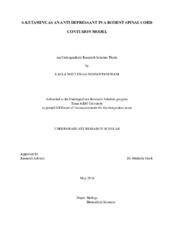| dc.description.abstract | In addition to the physical effects, spinal cord injury (SCI) also impacts quality of life and psychological wellbeing. Compared to the rate of 8.6% in the general population, the incidence of major depressive disorder (MDD) ranges from 11 to 24% in SCI patients (Krause et al., 2000). Currently, depression after SCI is treated with selective serotonin reuptake inhibitors (SSRIs), but these drugs have side effects that include attenuation of functional recovery after SCI (Coyle et al., 2015).
S-Ketamine is a novel drug that has shown potential as an antidepressant, but has not been assessed following SCI. To address this, we used a battery of established behavioral tests (sucrose preference, forced swim, open-field activity, social exploration, and burrowing tasks) to assess depression in a rodent SCI model. Subjects were acclimated to the behavioral tasks and baseline scores were collected two days before a moderate contusion injury. Twenty-four hours later, subjects were given an injection of 0, 5, 10, or 20 mg/kg S-ketamine (i.p.). Depression was re-assessed on days 2, 9-10, and 19-21 post-injury.
To characterize subjects as depressed or not-depressed, initial analyses focused on data collected on days 9-11 and 19-21 post-injury, after any potential antidepressant effects of S-ketamine should have dissipated. Using cluster analyses, we found that 13 out of 32 subjects (41%) displayed depression-like behaviors (decreased sucrose preference and open-field activity). Next, we examined the effects of S-ketamine. Analyzing data collected on day 2 post-injury, and within the window for S-ketamine’s efficacy, we found that 20 mg/kg ketamine increased social behavior, relative to all other dose groups. Importantly, depressed subjects treated with 20 mg/kg S-ketamine showed the highest level of social interaction 24 hours after administration. These data suggest that S-ketamine may be an effective antidepressant after SCI. Further studies are warranted to elucidate the molecular mechanisms mediating these effects and to optimize administration schedules. | en |


